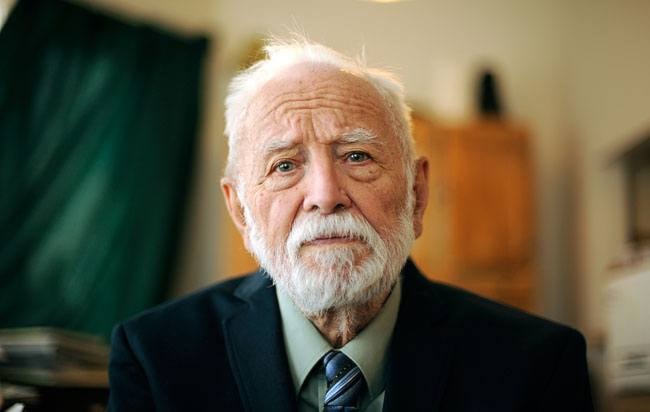Frederick Peacock once accepted a job where life expectancy was 45 minutes.
He was a teenager, his buddy was doing it and it sounded like it would be fun. The year was 1944 and the German Luftwaffe was dropping bombs on Britain. From an underground bunker Peacock could hear the bombers fly over and he waited for the sound of anti-aircraft fire sent up to shoot them down.
One day when walking across his soccer field, two German aircraft flew towards him so low he could see the faces of the pilots. They were coming to bomb the nearby Enfield munitions factory. Later two bombs dropped right in his town but did not explode. They hung in trees, live. When they were detonated they blew up two houses, and worst of all for the teenage boy, his cinema was destroyed.
Peacock wanted in on the action. For years he dreamed of becoming a pilot with the Royal Air Force but they didn’t need pilots then. It was tail gunners who were being killed within 45 minutes in battle. If he wanted to be in the air that was the only job available, take it or leave it. The 18 year old took it.
With London heavily bombed the recruits were sent to Scotland for training.
“The sergeant yelled at us to sit on the floor, strip the gun down, put it back together and then do that all over again blindfolded. We learned how to handle guns if they had fallen apart, jammed or if we were in the dark. It was fascinating,” the 88-year-old recalls.
Then came training in the tail gunner’s turret. It was a small glass cage, dark and cold, at the tail of the bomber. The tail gunner would be strapped in wearing a flying suit with electric wires in it for heat to prevent him from freezing to death. He had three layers of gloves and four machine guns. This teenager’s job was to protect Allied bombers from enemy aircraft by recognizing their approach and shooting them to pieces.
“We were trained in the Anson bomber first, then moved up to Wellingtons and last of all, the massive Lancaster bombers. Another aircraft would fly near us pulling a drogue - a sort of windsock on a cable and my job was to hit it.
“I would swivel the guns and look in the site to enable them to fire. When an aircraft approached, I’d check the wingspan and feed that into the device and then know the distance. Once I knew the wingspan I’d know what the bullets would do from that distance.”
Peacock went on night training missions over Wales, northern England and the North Sea where he practised firing thousands of rounds of ammunition. He knew in battle the turret was the first target of enemy fighters. He ignored the ominous name of the lever in the back of the Lancaster that moved the turret if the tail gunner could not. It was The Dead Man’s Lever. And as the war raged he might have guessed a great many tail gunners didn’t walk away from the turret - they were hosed out of the shattered cage.
In May 1945 Germany surrendered, but the war in the Pacific was still on. Allied forces flew safely over Germany to repatriate their own and to film the devastation. The now 19-year-old Peacock went on some missions to see what he had missed.
“We flew all over Germany. We went to all the big cities that were bombed. That was tremendous, no question. I remember the big German auto factory. It had been bombed to bits, what a mess! We flew over Denmark and saw an American aircraft downed on a river. I had a clear view. Dead, everyone on-board would’ve been dead,” he says wistfully.
Now he was selected for different training on the English coast.
“We had a rifle and we had to swing across rope bridges and crawl through dark maze-like tunnels to find our way out. They’d plant mines and if you crawled and put your fingers out you could find the landmines. We practised getting back into an upside-down boat in water. What were we heading for? We were told nothing.”
Eventually the truth became clear.
“I was shown films of Japanese aircraft and had to memorize them. That’s what the ground training was - how to escape if I was shot down in the jungle of Japan!”
Peacock was to be in the next deployment to Japan. But before he boarded America dropped the atomic bomb on Hiroshima. They surrendered and the Second World War ended just weeks before the British kid turned 20. He was never engaged in battle.
Decades later, Peacock moved to the Yukon and taught Air Cadets how to shoot a rifle in the basement of Whitehorse Elementary School. He was also a shop teacher at F.H. Collins Secondary School.
Looking back at the war years, he says he was too young to be afraid. “I didn’t worry. All I knew is I was trained to knock someone out of the air and I was trained to escape if I was shot down. We were there to do a job and we were going to do it regardless of how we felt. I guess I was very lucky.”
